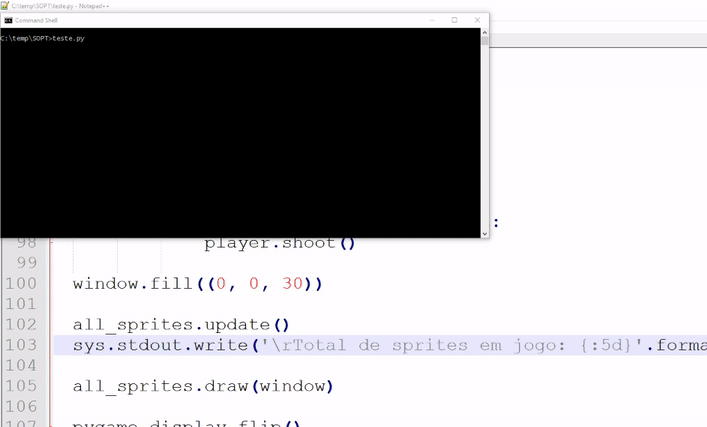Well, I'm trying to make a "ball" follow the playing rectangle, however it does not seem to be happening as the "ball" kind of blurs the screen when I move the player. I already tried to solve the problem and found nothing.
Previously I had the same problem just to draw a rectangle that moves and the problem was that I was using window.fill (color) after drawing the rectangle. This time it is not the case, even changing the place the function does nothing.
import pygame
pygame.init()
isRunning = True
WIDTH = 800
HEIGHT = 600
FPS = 60
clock = pygame.time.Clock()
window = pygame.display.set_mode((WIDTH, HEIGHT))
class Player(pygame.sprite.Sprite):
def __init__(self):
pygame.sprite.Sprite.__init__(self)
self.image = pygame.Surface((60, 30))
self.image.fill((200, 255, 200))
self.rect = self.image.get_rect()
self.rect.centerx = WIDTH / 2
self.rect.bottom = HEIGHT - 30
def update(self):
self.speedx = 0
keystate = pygame.key.get_pressed()
if keystate[pygame.K_a]:
self.speedx = -5
if keystate[pygame.K_d]:
self.speedx = 5
self.rect.x += self.speedx
if self.rect.right + self.speedx > WIDTH:
self.rect.right = WIDTH
if self.rect.left + self.speedx < 0:
self.rect.left = 0
ball = Ball(self.rect.centerx, self.rect.top)
for i in all_sprites:
print(i)
all_sprites.add(ball)
def shoot(self):
ball = Ball(self.rect.centerx, self.rect.top)
all_sprites.add(ball)
balls.add(ball)
class Ball(pygame.sprite.Sprite):
def __init__(self, x, y):
pygame.sprite.Sprite.__init__(self)
self.image = pygame.Surface((10, 10))
self.image.fill((100, 150, 200))
self.rect = self.image.get_rect()
self.rect.bottom = y
self.rect.centerx = x
self.speedy = -3
def update(self):
pass
#self.rect.y += self.speedy
all_sprites = pygame.sprite.Group()
balls = pygame.sprite.Group()
player = Player()
all_sprites.add(player)
while isRunning:
clock.tick(FPS)
for event in pygame.event.get():
if event.type == pygame.QUIT:
isRunning = False
if event.type == pygame.KEYDOWN:
if event.key == pygame.K_SPACE:
player.shoot()
window.fill((0, 0, 30))
all_sprites.update()
all_sprites.draw(window)
pygame.display.flip()
pygame.quit()
quit()






